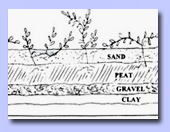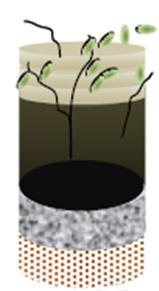 |
 |
 |
|
|
 |
How does the soil in a present day cranberry bog act like a code to tell us about the past? |
|
Lesson Plan: Overview
|
Visit a conventionally farmed summertime bog today, and you will see what’s at its surface: cranberry vines (and perhaps some weeds). But if you were to dig down and pull up a plug of soil, or core, you would be able to see the site’s past. Each layer of soil contributes to the health of the cranberry vine. Each layer also points to a specific event in geological or human history that in its own way helped create the right conditions for this useful fruit. Close to the surface, you would see evidence of the recent past. You would see the current cranberry root zone (where the roots of the vine are) in the sand layers built up by farmers. (Within this layer, additional detail might be evident. You might be able to distinguish between the layers of sand laid down every few winters and the organic matter that represents seasons of growth. ) Continuing your journey down through the core, beneath the sand, you would find peat, thousands of years old. Within this peat, there may even be chunks of old cedar, thousands of years dead, still slowly decomposing. Peat depth varies from bog to bog, and even from spot to spot, but can possibly be several feet deep or more. Under the peat would be the glacial deposits: first the larger gravel particles, and finally the watertight clay layer lining the underside of the bog. While the gravel ensures good water drainage from the roots, the clay barrier seals in nutrients that leach from peat. This maintains a rich environment for growth.
In the lesson, students compare three different soil samples (which you will prepare; see Materials, below): Core Samples X, Y, and Z. The students’ job will be to interpret the layers and identify the core that represents a core from a grower’s cranberry bog (Core Sample Y).
|
| Credits |

